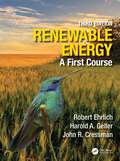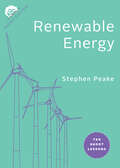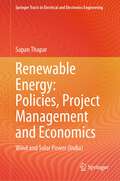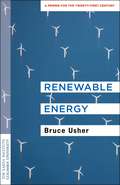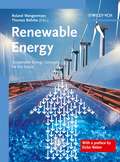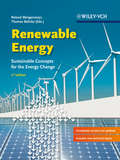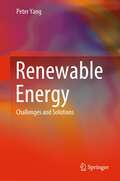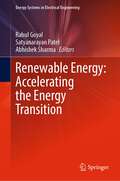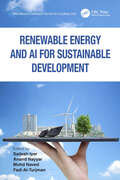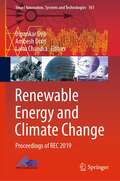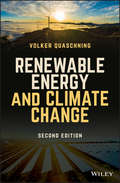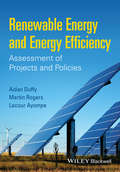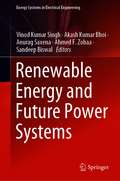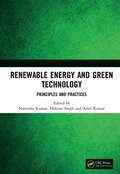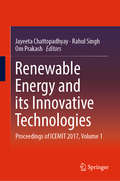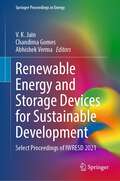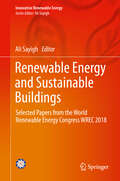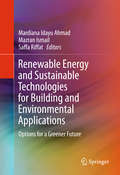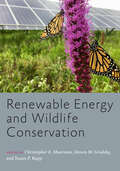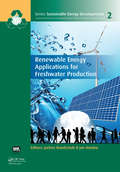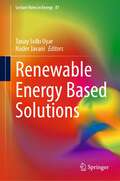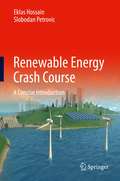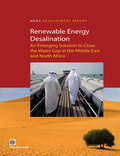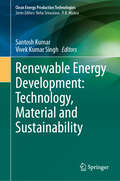- Table View
- List View
Renewable Energy: A First Course
by Robert Ehrlich Harold A. Geller John R. CressmanThis revised edition of Renewable Energy: A First Course is fully updated and continues to provide the best in-depth introduction to renewable energy science. The book focuses mainly on renewable energy, but also addresses nonrenewable energy (fossil fuels and nuclear technology). The coverage extends from the basic physics to conservation, economic, and public policy issues, with strong emphasis on explaining how things work in practice. The authors avoid technical jargon and advanced math but address fundamental analytical skills with wide application. Updated statistics, figures, policies, trends, and technological advancements will bring the reader up to speed with the current state of renewable energy.
Renewable Energy: Ten Short Lessons (Pocket Einstein Series)
by Stephen PeakeAn expert introduction to the fascinating world of renewable energy and the transition from fossil fuels to clean energy that lies at the heart of a brighter climate future.In Renewable Energy: Ten Short Lessons, Stephen Peake distills the key issues of this timely subject, examining how we can harness the power of a range of groundbreaking energy technologies most effectively to achieve a sustainable energy future. Renewable energy is central to managing climate change and our transition to a sustainable energy supply for the 10 billion of us who will populate the earth by 2050. But how will we cope without fossil fuels to heat, cool, and light our buildings, power our industry, and run our transport systems? And are some renewables better than others? Packed full of easy-to-understand diagrams and fact boxes, these ten lessons cover all the basics, as well as the latest understanding and developments, to enlighten the nonscientist. About the series: The Pocket Einstein series is a collection of essential pocket-sized guides for anyone looking to understand a little more about some of the most important and fascinating areas of science in the twenty-first century. Broken down into ten simple lessons and written by leading experts in their field, the books reveal the ten most important takeaways from those areas of science you've always wanted to know more about.
Renewable Energy: Wind and Solar Power (India) (Springer Tracts in Electrical and Electronics Engineering)
by Sapan ThaparThis book has been written with an aim to enhance the understanding of renewable energy sector policies, finance, and project management. It provides a comprehensive update on renewable energy policies and fiscal instruments, employed globally, with detailed discussions on the Indian policy regime. The book covers various stages of a renewable energy project, from concept to commissioning, and elucidates methodology for computing key financial ratios. A number of case studies, business models, and examples have been presented. Fundamental concepts on technologies, performance, financial tools, and carbon emissions have been explained to enable readers to assimilate the concepts. Data has been presented in easy-to-understand charts, figures, excel spreadsheets, and tables. This book will be useful for the stakeholders associated with the energy sector – corporate professionals, utility personnel, entrepreneurs, investors, bankers, and policymakers. It shall also serve as a textbook for university students as well as research scholars pursuing courses in energy.
Renewable Energy: A Primer for the Twenty-First Century (Columbia University Earth Institute Sustainability Primers)
by Professor Bruce UsherFrom wood to coal to oil and gas, the sources of energy on which civilization depends have always changed as technology advances. Now renewables are overtaking fossil fuels, with wind and solar energy becoming cheaper and more competitive every year. Growth in renewable energy will further accelerate as electric vehicles become less expensive than traditional automobiles. Understanding the implications of the energy transition will prepare us for the many changes ahead.This book is a primer for readers of all levels on the coming energy transition and its global consequences. Bruce Usher provides a concise yet comprehensive explanation for the extraordinary growth in wind and solar energy; the trajectory of the transition from fossil fuels to renewables; and the implications for industries, countries, and the climate. Written in a straightforward style with easy-to-understand visual aids, the book illuminates the strengths and weaknesses of renewable energy based on business fundamentals and analysis of the economic forces that have given renewables a tailwind. Usher dissects the winners and losers, illustrating how governments and businesses with a far-sighted approach will reap long-term benefits while others will trail behind. Alongside the business and finance case for renewable energy, he provides a timely illustration of the threat of catastrophic climate change and the perils of delay. A short and powerful guide to our energy present and future, this book makes it clear that, from both economic and environmental perspectives, there is no time to lose.
Renewable Energy: Sustainable Energy Concepts for the Future
by Roland Wengenmayr Thomas BührkeThis translation of a German title, which was enthusiastically received by a wide audience, collects contributions by leading and well-known scientists in the area explaining the technical basics of photovoltaic, solar thermal energy, wind and water power as well as geothermal energy. In an easily accessible yet sober way, the book offers a solid overview of the possibilities offered by environmentally friendly techniques, energy conversion, storage, and transportation, discussing the topic without any misplaced ideology. The editors are experienced journalists and illustrate the text with simple diagrams and information boxes, printed in full-color throughout. For applied physicists, engineers in power technology, engineers, and anyone interested in natural sciences.
Renewable Energy: Sustainable Energy Concepts for the Energy Change
by Roland Wengenmayr Thomas BührkeIn the years since the publication of the first edition of this book, the world has undergone drastic changes in terms of energy sources. This is reflected in the expansion of this second edition from 20 to 26 chapters. The most dramatic occurrence was the Tsunami which struck Japan in March of 2011 and set off a reactor catastrophe at the nuclear power plants in Fukushima. On the other hand fossil fuel technology drives the climate change to a threatening level. So, renewable energy sources are essential for the 21st century. The increasing number of wind power plants, solar collectors and photovoltaic installations demonstrates perceptibly that many innovations for tapping renewable energy sources have matured: very few other technologies have developed so dynamically in the past years.Nearly all the chapters were written by professionals in the respective fields. That makes this book an especially valuable and reliable source of information. The second edition is extended by several new chapters such as tidal power stations, the Desertec project, thermography of buildings and more. Furthermore, the critical debate about current first generation bio-fuels is carefully reflected, and the book presents promising solutions that do not trade in food for fuel. The editors are experienced journalists and illustrate the text with simple diagrams and information boxes, printed in full-color throughout. A valuable resource for applied physicists, engineers in power technology, engineers, and anyone interested in natural sciences.
Renewable Energy: Challenges and Solutions
by Peter YangThis book empowers college students and young professionals to develop a critical capacity of climate action in the energy transformation, which is necessary to address unprecedented climate crises. It illuminates the monumental challenges and pioneering solutions in accelerating renewable energy technologies, including solar energy, wind power, bioenergy, hydropower, and geothermal energy, as well as energy storage, along with their practical applications. The book offers the most current insights into innovations in renewable energy and energy storage, which are pivotal in forging a reliable and sustainable future powered exclusively by renewables. Its chapters equip the younger generation with the knowledge and critical skills needed to become well-informed and discerning professionals, ready to meet the demands of future sustainable job markets. Readers are encouraged to actively engage in and contribute to the ongoing revolution in renewable energy and energy storage.
Renewable Energy: Accelerating the Energy Transition (Energy Systems in Electrical Engineering)
by Rahul Goyal Satyanarayan Patel Abhishek SharmaThis book reveals key challenges to ensuring the secure and sustainable production and use of energy resources and provides corresponding solutions. This book covers the advanced technologies applied in renewable energy generation, energy storage, an alternative to petroleum fuels, waste to energy, solar energy, the impact of fossil fuel combustion on the environment, green buildings, social sustainability, etc. It goes beyond theory and describes practical challenges and solutions associated with energy and sustainability. This book is of particular interest to graduate students and academic or industrial researchers/professionals working in renewable energy, sustainability, bioenergy, and mechanical and automobile engineering. This book makes a forceful foundation for the establishment of the role of renewable energy in energy transition for a sustainable, cleaner, and greener future. This book is unique compared to other available books because it covers a wide variety of topics on a single platform.
Renewable Energy and AI for Sustainable Development (Innovations in Intelligent Internet of Everything (IoE))
by Sailesh Iyer Anand Nayyar Mohd Naved Fadi Al-TurjmanElectronic device usage has increased considerably in the past two decades. System configurations are continuously requiring upgrades; existing systems often become obsolete in a matter of 2–3 years. Green computing is the complete effective management of design, manufacture, use, and disposal, involving as little environmental impact as possible. This book intends to explore new and innovative ways of conserving energy, effective e-waste management, and renewable energy sources to harness and nurture a sustainable eco-friendly environment. This book: • Highlights innovative principles and practices using effective e-waste management and disposal • Explores artificial intelligence based sustainable models • Discovers alternative sources and mechanisms for minimizing environmental hazards • Highlights successful case studies in alternative sources of energy • Presents solid illustrations, mathematical equations, as well as practical in-the-field applications • Serves as a one-stop reference guide to stakeholders in the domain of green computing, e-waste management, renewable energy alternatives, green transformational leadership including theory concepts, practice and case studies • Explores cutting-edge technologies like internet of energy and artificial intelligence, especially the role of machine learning and deep learning in renewable energy and creating a sustainable ecosystem • Explores futuristic trends in renewable energy This book aims to address the increasing interest in reducing the environmental impact of energy as well as its further development and will act as a useful reference for engineers, architects, and technicians interested in and working with energy systems; scientists and engineers in developing countries; industries, manufacturers, inventors, universities, researchers, and interested consultants to explain the foundation to advanced concepts and research trends in the domain of renewable energy and sustainable computing. The content coverage of the book is organized in the form of 11 clear and thorough chapters providing a comprehensive view of the global renewable energy scenario, as well as how science and technology can play a vital role in renewable energy.
Renewable Energy and Climate Change: Proceedings of REC 2019 (Smart Innovation, Systems and Technologies #161)
by Laltu Chandra Ambesh Dixit Dipankar DebThis book gathers selected papers presented at the First International Conference on Renewable Energy and Climate Change (REC 2019), which was held at the Institute of Infrastructure Technology Research and Management (IITRAM) from 1 to 2 February 2019. The topics covered include renewable (green) energy and sources including wind power, hydropower, solar energy, biomass, biofuel, geothermal energy, wave energy, tidal energy, hydrogen & fuel cells, energy storage, new trends and technologies for renewable energies, policies and strategies for renewable energies, smart grids, batteries, and e-mobility, control techniques for renewable energies, hybrid renewable energies, renewable energy research and applications for industries, applications of renewable energies in electrical vehicles and other allied areas, artificial intelligence and machine learning studies for renewable energies, renewable energy systems in smart cities, climate change mitigation, carbon trading, carbon capture and utilization, and carbon dioxide refrigeration systems.
Renewable Energy and Climate Change, 2nd Edition (Wiley - Ieee Ser.)
by Volker V. QuaschningProvides clear analysis on the development potentials and practical realization of solar, wind, wave, and geothermal renewable energy technologies Presented as a clear introduction to the topics of climate protection and renewable energy, this book demonstrates the correlations between use of energy, energy prices, and climate change. It evaluates and analyzes the current world situation (drawing on examples given from countries across the globe), whilst also giving essential and practical guidance on ‘personal’ climate protection. Each major type of renewable energy system is covered in detail and with an easy-to-read approach, making it an ideal manual for planning and realizing climate protection and renewable energy systems, while also being an informative textbook for those studying renewable energy and environment and sustainability courses. Renewable Energy and Climate Change, 2nd Edition starts by examining our hunger for energy—how much we need, how much we use, and how much it is costing us. It then looks at the state of climate change today and the causes. Following that, the book focuses on how we waste and save energy. The remaining chapters look at the many alternative sources of energy generation, like photovoltaics, solar thermal systems and power plants, wind power systems, hydropower plants, and geothermal power. The book also delves into current state of biomass energy and the hydrogen and fuel cell industry. It finishes with a look at the future of the subject, shining a light on some positive examples of sustainable energy. Clear overview on each state-of-the-art technology in alternative energy production Presents correlations between use of energy and energy prices, and climate change Provides guidance on what the reader can do to reduce their own energy waste Full-color figures and photographs throughout, data diagrams and simple calculations and results, and text boxes that highlight important information International examples of renewable energy in action Renewable Energy and Climate Change, 2nd Edition is an excellent text for students and professionals studying or working on renewable energy, or environmental and sustainability alternatives. It will also benefit planners, operators, financers, and consultants in those fields.
Renewable Energy and Climate Change, 2nd Edition (Wiley - Ieee Ser.)
by Volker V. QuaschningProvides clear analysis on the development potentials and practical realization of solar, wind, wave, and geothermal renewable energy technologies Presented as a clear introduction to the topics of climate protection and renewable energy, this book demonstrates the correlations between use of energy, energy prices, and climate change. It evaluates and analyzes the current world situation (drawing on examples given from countries across the globe), whilst also giving essential and practical guidance on ‘personal’ climate protection. Each major type of renewable energy system is covered in detail and with an easy-to-read approach, making it an ideal manual for planning and realizing climate protection and renewable energy systems, while also being an informative textbook for those studying renewable energy and environment and sustainability courses. Renewable Energy and Climate Change, 2nd Edition starts by examining our hunger for energy—how much we need, how much we use, and how much it is costing us. It then looks at the state of climate change today and the causes. Following that, the book focuses on how we waste and save energy. The remaining chapters look at the many alternative sources of energy generation, like photovoltaics, solar thermal systems and power plants, wind power systems, hydropower plants, and geothermal power. The book also delves into current state of biomass energy and the hydrogen and fuel cell industry. It finishes with a look at the future of the subject, shining a light on some positive examples of sustainable energy. Clear overview on each state-of-the-art technology in alternative energy production Presents correlations between use of energy and energy prices, and climate change Provides guidance on what the reader can do to reduce their own energy waste Full-color figures and photographs throughout, data diagrams and simple calculations and results, and text boxes that highlight important information International examples of renewable energy in action Renewable Energy and Climate Change, 2nd Edition is an excellent text for students and professionals studying or working on renewable energy, or environmental and sustainability alternatives. It will also benefit planners, operators, financers, and consultants in those fields.
Renewable Energy and Energy Efficiency
by Lacour Ayompe Aidan Duffy Martin RogersThe recent rise to prominence of renewable energy and energy efficiency has been driven by their potential to lower the environmental impacts of energy use. As these technologies mature they must demonstrate not only their environmental benefits, but also their economic competitiveness. The relative costs and benefits of each potential project, whether large or small, must be systematically modelled and assessed before they can be financed and implemented.Renewable Energy and Energy Efficiency: Assessment of Projects and Policies deals with the appraisal of such projects against financial and non-financial criteria, illustrating the assessment tools necessary to make appropriate, evidence based decisions as efficiently as possible. The most important technologies are first described, stressing their economic and performance characteristics. Key project appraisal concepts are then introduced, approaches to modelling the cash flows in energy projects are described, and the issues of uncertainty and optimisation are fully discussed. These financial concepts, together with methods for estimating greenhouse gas emissions, are extended to address aspects of energy policy. Illustrated with many case studies this is an ideal introduction to financial and non-financial appraisal techniques as applied to energy efficient and renewable energy technologies.
Renewable Energy and Future Power Systems (Energy Systems in Electrical Engineering)
by Vinod Kumar Singh Akash Kumar Bhoi Anurag Saxena Ahmed F. Zobaa Sandeep BiswalThis book discusses advanced technologies for applications in renewable energy and power systems. The topics covered include neural network applications in power electronics, deep learning applications in power systems, design and simulation of multilevel inverters, solid state transformers, neural network applications for fault detection in power electronics, etc. The book also discusses the important role of artificial intelligence in power systems, and machine learning for renewable energy. This book will be of interest to researchers, professionals, and technocrats looking at power systems, power distribution, and grid operations.
Renewable Energy and Green Technology: Principles and Practices
by Narendra KumaRenewable Energy and Green Technology: Principles and Practices is based on the present need to understand the principles and utility of renewable energy and green technology to minimize dependency on fossil fuels in global development. Renewable energy is the best and cheapest source of energy as an alternate resource. There is massive potential for renewable energy globally, including in India. The efficient utilization of renewable energy resources could minimize the impact of climate change globally. Generally, renewable energy is generated from essentially inexhaustible sources, including wind power, solar power, geothermal energy, tidal energy, biomass energy, and other sources. Hence, encouraging renewable energy use could save our tomorrow from the climate change perspective and in terms of sustainable food production. This book promotes the exchange of ideas, policy formulation, and collective action to ensure a smooth transition to renewable energy. It describes the technological interventions for reducing environmental and economic damage resulting from the use of conventional energy sources. In this book, the focus is on utilizing various renewable energy sources in diverse sectors. It also elaborates the descriptive methodology of different renewable energies, accompanied by figures and tables. It provides information on biogas energy plants, gasifier technologies, and hydropower technologies, among others, along with their applications. Further, it delves into energy concepts and details significant advantages of the energy resources for sustaining the future world. Lastly, this book will provide instant access to comprehensive, cutting-edge knowledge, making it possible for academicians and researchers to utilize this ever-growing wealth of information. Key features Emphasizes the understanding of the principles and utility of renewable energy and green technology to minimize dependency on fossil fuels in the era of global development Focuses on recent trends in renewable energy with principles and practices in relation to climate change Highlights advanced approaches for sustainable use of renewable energy sources Illustrates the methodology for various aspects of renewable energy with figures and charts Discusses the green technology usages of the agriculture and forestry sectors Provides comprehensive cutting-edge information for policymakers in the field of renewable energy
Renewable Energy and its Innovative Technologies: Proceedings of ICEMIT 2017, Volume 1
by Jayeeta Chattopadhyay Rahul Singh Om PrakashThe book features innovative scientific research by scientists, academicians and students, presented at the International Conference on Energy, Materials and Information Technology, 2017 at Amity University Jharkhand, India. Covering all the promising renewable energies and their related technologies, such as wind, solar and biomass energy, it compiles current important scientific research in this field and addresses how it can be applied in an interdisciplinary manner. The selected conference papers provide important data and parameters for utilizing the main potential renewable energies, and allowing an economic and environmental assessment.The book is a valuable resource for all those who are interested in the physical and technical principles of promising ways to utilize various renewable energies.
Renewable Energy and Storage Devices for Sustainable Development: Select Proceedings of IWRESD 2021 (Springer Proceedings in Energy)
by V. K. Jain Chandima Gomes Abhishek VermaThe book contains selected and peer-reviewed papers presented during the ‘International Workshop on Renewable Energy and Storage Devices for Sustainable Development’ (IWRESD-2021). The book covers recent research on various applications and scientific developments in the areas of renewable energy. These topics are solar cells, sustainable energy conversion, processing technologies, instrumentation, energy storage devices, solar thermal applications, batteries, new materials, and processes to develop low-cost renewable energy-based technologies, etc. This book will be of interest to researchers and engineers across a variety of fields.
Renewable Energy and Sustainable Buildings: Selected Papers from the World Renewable Energy Congress WREC 2018 (Innovative Renewable Energy)
by Ali SayighThis book contains selected papers presented during the World Renewable Energy Network’s 28thanniversary congress at the University of Kingston in London. The forum highlighted the integration of renewables and sustainable buildings as the best means to combat climate change. In-depth chapters written by the world’s leading experts highlight the most current research and technological breakthroughs and discuss policy, renewable energy technologies and applications in all sectors – for heating and cooling, agricultural applications, water, desalination, industrial applications and for the transport sectors.Presents cutting-edge research in green building and renewable energy from all over the world;Covers the most up-to-date research developments, government policies, business models, best practices and innovations;Contains case studies and examples to enhance practical application of the technologies.
Renewable Energy and Sustainable Technologies for Building and Environmental Applications
by Mardiana Idayu Ahmad Mazran Ismail Saffa RiffatThis diverse resource on renewableenergy and sustainable technologies highlights the status, state of the art,challenges, advancements and options in areas such as energy recovery systems,turbine ventilators, green composites, biofuels andbio-resources for energy production, wind energy, integrated energy-efficientsystems, thermal energy storage, natural ventilation & day-lightingsystems, and low carbon technologies for building and environmentalapplications. It is designed to serve as a reference book for students,researchers, manufacturers and professionals working in these fields. Theeditors have gathered articles from world-leading experts that clearlyillustrate key areas in renewable energy and sustainability. The distinct roleof these technologies in future endeavors is stressed by taking into accountthe opportunities to contribute with new approaches, methods and directions forbuilding and environmental applications. The in-depth discussion presented inthis book will give readers a clear understanding of every important aspect ofeach technology's applications, optimum configuration, modifications,limitations and their possible improvements.
Renewable Energy and Wildlife Conservation (Wildlife Management and Conservation)
by Christopher E. Moorman Steven M. Grodsky Susan RuppBrings together disparate conversations about wildlife conservation and renewable energy, suggesting ways these two critical fields can work hand in hand.Renewable energy is often termed simply "green energy," but its effects on wildlife and other forms of biodiversity can be quite complex. While capturing renewable resources like wind, solar, and energy from biomass can require more land than fossil fuel production, potentially displacing wildlife habitat, renewable energy infrastructure can also create habitat and promote species health when thoughtfully implemented.The authors of Renewable Energy and Wildlife Conservation argue that in order to achieve a balanced plan for addressing these two crucially important sustainability issues, our actions at the nexus of these fields must be directed by current scientific information related to the ecological effects of renewable energy production. Synthesizing an extensive, rapidly growing base of research and insights from practitioners into a single, comprehensive resource, contributors to this volume• describe processes to generate renewable energy, focusing on the Big Four renewables—wind, bioenergy, solar energy, and hydroelectric power• review the documented effects of renewable energy production on wildlife and wildlife habitats• consider current and future policy directives, suggesting ways industrial-scale renewables production can be developed to minimize harm to wildlife populations• explain recent advances in renewable power technologies• identify urgent research needs at the intersection of renewables and wildlife conservationRelevant to policy makers and industry professionals—many of whom believe renewables are the best path forward as the world seeks to meet its expanding energy needs—and wildlife conservationists—many of whom are alarmed at the rate of renewables-related habitat conversion—this detailed book culminates with a chapter underscoring emerging opportunities in renewable energy ecology.Contributors: Edward B. Arnett, Brian B. Boroski, Regan Dohm, David Drake, Sarah R. Fritts, Rachel Greene, Steven M. Grodsky, Amanda M. Hale, Cris D. Hein, Rebecca R. Hernandez, Jessica A. Homyack, Henriette I. Jager, Nicole M. Korfanta, James A. Martin, Christopher E. Moorman, Clint Otto, Christine A. Ribic, Susan P. Rupp, Jake Verschuyl, Lindsay M. Wickman, T. Bently Wigley, Victoria H. Zero
Renewable Energy Applications for Freshwater Production (Sustainable Energy Developments)
by Jochen Bundschuh Jan HoinkisWorldwide, many regions have a great potential to cover part of their pressing water needs by renewable energy powered water treatment processes using either thermal or membrane based technologies. Not only arid and semiarid regions are increasingly suffering from water shortage but also many other regions face a limitation of freshwater resources either by increasing contamination of surface water bodies or groundwater resources unsuitable for drinking and irrigation purposes either due to their high grade of mineralization or their contents of toxic components. In many areas without centralized water supply, treatment techniques using locally available renewable energy resources such as wind, solar and geothermal can provide an economical, social and environmentally sustainable option for clean water production from seawater and from highly mineralized or otherwise unsuitable ground- and surface water. This book provides an overview on possible cost-efficient techniques and application opportunities for different scales and shows why the implementation of these technologies faces numerous technological, economic and policy barriers and provides suggestions how they can be overcome. It serves as a synoptic compendium of the fundamentals of freshwater production using renewable energies, applicable to all types of water, ranging from brackish to marine water and also including industrial and communal residual water. The book is aimed at professionals, academics and decision makers worldwide, working in the areas of water resources, water supply,land planning, energy planning, greenhouse gases emission mitigation and rural development.
Renewable Energy Based Solutions (Lecture Notes in Energy #87)
by Tanay Sıdkı Uyar Nader JavaniThis book discusses the main renewable energy resources, along with the current challenges that make it difficult achieve 100% decarbonized energy sources. It presents the perspectives of international expert authors in the field, giving readers a multi-dimensional view of the subject.The book explores numerous approaches for a smooth transition from fossil fuels to renewable energies, including those based on engineering methods, as well as policies, strategies, and social perceptions. It presents several case studies and examples from industry, showcasing the potential role of renewable sources and their challenges. The inclusion of both established methods and cutting-edge developments will make this book of interest to academics, industry professionals, policy makers, and graduate students alike.
Renewable Energy Crash Course: A Concise Introduction
by Eklas Hossain Slobodan PetrovicThis book is a concise reader-friendly introductory guide to understanding renewable energy technologies. By using simplified classroom-tested methods developed while teaching the subject to engineering students, the authors explain in simple language an otherwise complex subject in terms that enable readers to gain a rapid fundamental understanding of renewable energy, including basic principles, the different types, energy storage, grid integration, and economies. This powerful tutorial is a great resource for students, engineers, technicians, analysts, investors, and other busy professionals who need to quickly acquire a solid understanding of the science of renewable energy technology.
Renewable Energy Desalination
by Bekele Debele NegewoThe Middle East and North Africa (MENA) Region is one of the most water stressed regions in the world. Water scarcity has already become a challenge to development in many of the countries. Due to increasing population and Projected climate change impacts, MENA's annual water demand gap is projected to grow five-fold by 2050, from today's 42 Km3 to 200 km3 by 2050. Despite its extreme scarcity, water is managed poorly. Inefficiencies are common in the agriculture, municipal and industrial systems; and many utilities are financially unsustainable. As a result, countries overexploit their fossil aquifers-and use desalination by fossil fuel-to meet the water demand gap. Desalination already plays a critical role in MENA's water supply portfolio. However, desalination is costly, energy intensive and has environmental impacts. On current trends, the projection is that, by 2050, Saudi Arabia and many other countries in the Region will consume for desalination most of the oil that they produce. Overexploitation of fossil aquifers is not sustainable. Neither is the use of fossil fuel for desalination to meet the growing water gap sustainable. This book outlines the challenges in terms of water (and also in terms of energy) that countries in the Region face and analyzes the scope of available options to address the growing water gap. The book estimates MENA's water gap today and into the future-until 2050; and presents a methodology to prioritize options to bridge the water gap, using the 'marginal cost of water' approach. The book also assesses the viability of renewable energy desalination as an important option to close the Region's water gap. The book compares the economic cost of desalination using fossil fuel and renewable energy sources, in particular the Concentrated Solar Power (CSP). The book also provides recommendations as to how CSP based desalination could ensure sustainable water supply for the Region.
Renewable Energy Development: Technology, Material and Sustainability (Clean Energy Production Technologies)
by Santosh Kumar Vivek Kumar SinghThis edited volume is a comprehensive guide to understanding and harnessing the power of renewable energy for a sustainable future. In a world dealing with the urgent need to combat climate change and reduce our dependence on fossil fuels, this book provides a new perspective on renewable energy. It is filled with cutting-edge research and practical insights, exploring the technologies, advanced materials, and sustainability practices driving the renewable energy revolution. Renewable energy resources are developing the latest advancements in solar, wind, hydro, geothermal, biomass, tidal, and wave energy technologies. This book is unique and opens a new window on classic renewable energy sources as well as new developments in technology, advanced material innovation, and sustainability aspects leading with various factors such as energy storage, transmission, institutional and economic factors, renewable energy application in smart cities, building and other solar thermal applications, environmental aspects, electrical energy generation, and climate change mitigation potential to achieve net-zero targets. This book is of interest to teachers, researchers, climate change scientists, capacity builders, and policymakers. Additionally, the book serves as an additional reading material for undergraduate and graduate students of sustainable energy, engineering, material science, and environmental sciences. National and international energy, sustainable and material scientists, managers, and policymakers will also find this to be a useful read.
